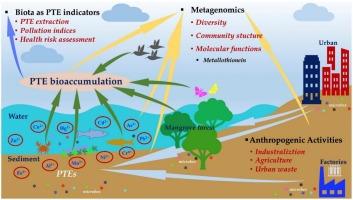红树林生态系统中潜在有毒元素的生物指标
IF 10
1区 地球科学
Q1 GEOSCIENCES, MULTIDISCIPLINARY
引用次数: 0
摘要
红树林生态系统受到源自人类活动的有毒元素污染的风险日益增加。生态系统固有的生物指示生物可以用来评估污染程度。微生物是利用生物指标评价环境质量应用最多的生物群,因为它们可以通过高通量宏基因组测序技术进行评价。本文综述了红树林生态系统中潜在有毒元素(PTE)的积累、相关生物指标以及金属和生物群的分析方法。这篇综述探讨了微生物与关键环境变量(如pH、氧化还原电位和盐度)的相互作用。介绍了典型红树林生态系统中特定金属及其相关生物指标的行为。综述了微生物指标的丰度、组成及其宏基因组学分析。目前的综述重点是红树林生态系统,为理解PTE生物指标及其与环境的相互作用提供了基础。这些发现可以支持未来基于生物指标的项目,包括生态系统健康评估和元基因组学驱动的保护和恢复监测。本文章由计算机程序翻译,如有差异,请以英文原文为准。

Bioindicators of potentially toxic elements in Mangrove ecosystems
Mangrove ecosystems are facing an increased risk of contamination from toxic elements originating from anthropogenic activities. Bioindicating organisms indigenous to an ecosystem can be used to assess the degree of pollution. Microorganisms are the most applied biota in the evaluation of environmental quality using bioindicators, as they can be evaluated via high-throughput metagenomics sequencing technology. The current review provides a comprehensive report of potentially toxic element (PTE) accumulation, associated bioindicators, and analytical approaches for metals and biota in mangrove ecosystems. The review explores microbial interactions with key environmental variables such as pH, redox potential, and salinity. The behaviors of specific metals and related bioindicators in a typical mangrove ecosystem are presented. The review focuses on microbial bioindicators, their abundance and composition, and their analysis via metagenomics. The current review, with emphasis on mangrove ecosystems, provides a foundation for understanding PTE bioindicators and their interactions with the environment. These findings can support future bioindicator-based programs, including ecosystem health assessments and metagenomics-driven monitoring for conservation and restoration.
求助全文
通过发布文献求助,成功后即可免费获取论文全文。
去求助
来源期刊

Earth-Science Reviews
地学-地球科学综合
CiteScore
21.70
自引率
5.80%
发文量
294
审稿时长
15.1 weeks
期刊介绍:
Covering a much wider field than the usual specialist journals, Earth Science Reviews publishes review articles dealing with all aspects of Earth Sciences, and is an important vehicle for allowing readers to see their particular interest related to the Earth Sciences as a whole.
 求助内容:
求助内容: 应助结果提醒方式:
应助结果提醒方式:


